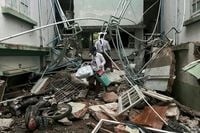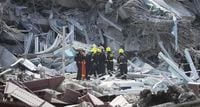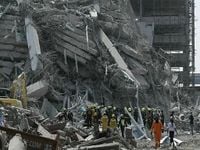On March 28, 2025, a devastating earthquake struck Myanmar, registering a magnitude of 7.7 on the Richter scale. The tremors were felt across neighboring countries, including Thailand, China, and India, causing widespread panic and chaos. Images circulating on social media depicted the destruction in Mandalay, Myanmar's second-largest city, and even in the Thai capital, Bangkok.
According to General Min Aung Hlaing, the head of Myanmar's military government, the earthquake has resulted in at least 1,007 fatalities and left 2,389 others injured. Most of the casualties were reported in Mandalay, where the destruction was particularly severe. The number of dead and injured is expected to rise as rescue efforts continue and communication remains disrupted in many areas.
The earthquake struck around noon local time, with a powerful aftershock of magnitude 6.4 occurring shortly thereafter. This series of tremors has raised fears of a major catastrophe in a country already burdened by ongoing civil unrest since 2021. American geologists noted that it has been decades since Myanmar experienced an earthquake of this magnitude.
Scenes of chaos unfolded as buildings, homes, bridges, and religious sites crumbled, leaving many residents trapped under debris. Reports suggest that over 90 individuals may still be trapped beneath a 12-story residential building in Mandalay. Rescue workers have been mobilized, but the scale of the disaster is complicating their efforts.
In Thailand, the impact of the earthquake was also felt, with authorities in Bangkok confirming that ten people have died, 16 were injured, and 101 are missing from three construction sites, including a high-rise building that collapsed. The Thai Minister of Public Health, Somsak Thepsuthin, indicated that there were 409 workers present at the site when the building fell.
Images from Bangkok depicted citizens rushing into the streets, leaving behind homes, businesses, and hospitals as they sought safety. Although Thailand is not typically known for seismic activity, the high-rise structures in Bangkok are not designed to withstand such powerful earthquakes, leading to significant damage, especially in incomplete buildings.
The Thai government has declared a state of emergency and is coordinating a response to the disaster. More than 100 experts have been dispatched to assess the safety of buildings following over 2,000 reports of damage. Rescue teams are using advanced technology, including thermal imaging, to locate survivors under the rubble, with hopes of finding at least 15 people alive.
In Myanmar, the military government has declared a state of emergency in six of the most affected regions and has requested international assistance. General Hlaing made a rare appeal for help, inviting any nation or organization to provide aid, a departure from past reluctance to seek foreign support following natural disasters.
International responses have begun to materialize, with a plane from India arriving in Yangon carrying essential supplies such as hygiene products, blankets, and food. China has announced the dispatch of a rescue team comprising 82 personnel, while other countries, including Japan and members of the European Union, have offered their assistance.
Humanitarian organizations have warned that Myanmar is ill-prepared to handle a disaster of this magnitude, especially given the ongoing civil conflict that has displaced approximately 3.5 million people. The United Nations has previously cautioned that 15 million people in Myanmar could face starvation by 2025 due to the compounded effects of war and now, this earthquake.
As rescue operations continue, the situation remains dire, with many still unaccounted for and the full extent of the damage yet to be assessed. In Mandalay, the destruction of historical temples and infrastructure has intensified the urgency for aid and support.
The Thai governor, Chadchart Sittipunt, expressed his commitment to saving lives, stating, “We are replacing parts of our efforts with available resources because every life is important.” In a sobering reminder of the human cost of such disasters, the chaos has left many families in mourning and searching for their loved ones.
As the days unfold, the focus will remain on recovery efforts and the international community’s response to this tragic event. The people of Myanmar and Thailand now face the daunting task of rebuilding their lives in the wake of this catastrophic earthquake.







